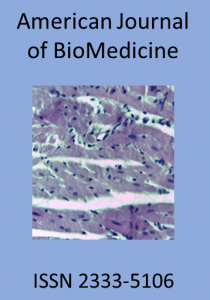American Journal of BioMedicine
Volume 11, Issue 1, 04 January 2023, Pages 1-9 | http://dx.doi.org/10.18081/2333-5106/2023.11/1
Martín Pérez-Vázquez 1, Psarova O. V 1, 2, Palero S *1
Received 10 September 2022 Revised 14 November 2022 Accepted 03 December 2022 Published 04 January 2023
Abstract
The objective of this study is investigating the role of excessive activation PI3K/Akt/mTORC1 in diabetes mellitus type 2. It’s known that the PI3K/Akt/mTORC1 pathway is involved in the pathogenesis of cancer. Study design was carried out in accordance with the guidelines of the Helsinki Declaration that included normal patients as control (n = 15), second group included patients with diabetes mellitus type 2 (n = 22) while, third group included patients with malignancy positive mTORC1 (n = 22). 81 women were examined and enrolled in this study with age from 40 to 75-year-old. Diabetes mellitus type 2 compensation was assessed by determining the level of HbA1c by the method of ion-exchange chromatography, using the BIO-RAD D-10 analyzer, PRAS40 was determined in units depending on the amount of protein in the blood cell lysates.
Keywords: Diabetes mellitus type 2; mTORC1; PI3K/Akt
Copyright © 2023 Palero S, et al. This article distributed under the Creative Commons Attribution License, which permits unrestricted use, distribution, and reproduction in any medium, provided the original work is properly cited.
Cited by CrossRef (1)
Cited by Scopus (1)
| 1. Expert Committee on the Diagnosis and Classification of Diabetes Mellitus. Report of the Expert Committee on the Diagnosis and Classification of Diabetes Mellitus. Diabetes Care 1997; 20:1183-1197. https://doi.org/10.2337/diacare.20.7.1183 |
|||
| 2. Pradhan AD, Rifai N, Buring JE, Ridker PM. Hemoglobin A1c predicts diabetes but not cardiovascular disease in nondiabetic women. Am J Med 2007; 120:720-727. https://doi.org/10.1016/j.amjmed.2007.03.022 |
|||
| 3. Sato KK, Hayashi T, Harita N, Yoneda T, Nakamura Y, Endo G, Kambe H. Combined measurement of fasting plasma glucose and A1C is effective for the prediction of type 2 diabetes: the Kansai Healthcare Study. Diabetes Care 2009; 32:644-646. https://doi.org/10.2337/dc08-1631 |
|||
| 4. Knowler WC, Barrett-Connor E, Fowler SE, Hamman RF, Lachin JM, Walker EA, Nathan DM. Diabetes Prevention Program Research Group Reduction in the incidence of type 2 diabetes with lifestyle intervention or metformin. N Engl J Med 2002; 346:393-403. https://doi.org/10.1056/NEJMoa012512 |
|||
| 5. Kasuga M. Insulin resistance and pancreatic β-cell failure. J Clin Invest 2006; 116:1756- 1760. https://doi.org/10.1172/JCI29189 |
|||
| 6. Tuttle RL, Gill NS, Pugh W, et al. Regulation of pancreatic β-cell growth and survival by the serine/threonine protein kinase Akt1/PKBα. Nat Med 2001; 7:1133- 1137. https://doi.org/10.1038/nm1001-1133 |
|||
| 7. Bernal-Mizrachi E, Wen W, Stahlhut S, Welling CM, Permutt MA. Islet β-cell expression of constitutively active Akt1/PKBα induces striking hypertrophy, hyperplasia, and hyperinsulinemia. J Clin Invest 2001; 108:1631- 1638. https://doi.org/10.1172/JCI200113785 |
|||
| 8. Stiles BL, Kuralwalla-Martinez C, Guo W, et al. Selective deletion of Pten in pancreatic β-cells leads to increased islet mass and resistance to STZ-induced diabetes. Mol Cell Biol 2006; 26:2772- 2781. https://doi.org/10.1128/MCB.26.7.2772-2781.2006 |
|||
| 9. Wullschleger S, Loewith R, Hall MN. TOR signaling in growth and metabolism. Cell 2006; 124:471- 484. https://doi.org/10.1016/j.cell.2006.01.016 |
|||
| 10. Sarbassov DD, Ali SM, Sabatini DM. Growing roles for the mTOR pathway. Curr Opin Cell Biol 2005; 17:596- 603. https://doi.org/10.1016/j.ceb.2005.09.009 |
|||
| 11. Hara K, Maruki Y, Long X, et al. Raptor, a binding partner of target of rapamycin (TOR), mediates TOR action. Cell 2002; 110:177- 189. https://doi.org/10.1016/S0092-8674(02)00833-4 |
|||
| 12. Saucedo LJ, Gao X, Chiarelli DA, Li L, Pan D, Edgar BA. Rheb promotes cell growth as a component of the insulin/TOR signaling network. Nat Cell Biol 2003; 5:566- 571. https://doi.org/10.1038/ncb996 |
|||
| 13. Garami A, Zwartkruis FJT, Nobukuni T, et al. Insulin activation of Rheb, a mediator of mTOR/S6K/4E-BP signaling, is inhibited by TSC1 and 2. Mol Cell 2003; 11:1457- 1466. https://doi.org/10.1016/S1097-2765(03)00220-X |
|||
| 14. Yeung SC. PIM1 (pim-1 oncogene). Atlas Genet Cytogenet Oncol Haematol 2013; 17(10): 704-8. https://doi.org/10.4267/2042/51537 |
|||
| 15. Long X, Ortiz-Vega S, Lin Y, Avruch J: Rheb binding to mammalian target of rapamycin (mTOR) is regulated by amino acid sufficiency. J Biol Chem 2005; 280: 23433- 23436. https://doi.org/10.1074/jbc.C500169200 |
|||
| 16. Briaud I, Dickson LM, Lingohr MK, McCuaig JF, Lawrence JC, Rhodes CJ. Insulin receptor substrate-2 proteasomal degradation mediated by a mammalian target of rapamycin (mTOR)-induced negative feedback down-regulates protein kinase B-mediated signaling pathway in β-cells. J Biol Chem 2005; 280:2282- 2293. https://doi.org/10.1074/jbc.M412179200 |
|||
| 17. Wang H, Zhang Q, Wen Q, et al. Proline-rich Akt substrate of 40kDa (PRAS40): a novel downstream target of PI3k/Akt signaling pathway. Сell Signal 2012; 24(1): 17-24. https://doi.org/10.1016/j.cellsig.2011.08.010 |
|||
| 18. Rossing P. Diabetic nephropathy: worldwide epidemic and effects of current treatment on natural history. Curr Diab Rep. 2006; 6:479-83. https://doi.org/10.1007/s11892-006-0083-y |
|||
| 19. De Oliveira CE, Oda JM, Losi Guembarovski R, et al. CC chemokine receptor 5: the interface of host immunity and cancer. Dis Markers. 2014; 2014: 126954. https://doi.org/10.1155/2014/126954 |
|||
| 20. Senovilla L, Vacchelli E, Galon J, Adjemian S, Eggermont A, Fridman WH, et al. [Trial watch: Prognostic and predictive value of the immune infiltrate in cancer]. Oncoimmunology. 2012; 1(8):1323-1343. https://doi.org/10.4161/onci.22009 |
|||
| 21. Dituri F, Mazzocca A, Giannelli G, Antonaci S. PI3K functions in cancer progression, anticancer immunity and immune evasion by tumors]. Clin Dev Immunol. 2011; 2011:947858. https://doi.org/10.1155/2011/947858 |
|||
| 22. Inoki K, Zhu T, Guan KL. TSC2 mediates cellular energy response to control cell growth and survival. Cell. 2003;115:577-90. https://doi.org/10.1016/S0092-8674(03)00929-2 |
|||
| 23. Lu Q, Zuo WZ, Ji XJ, et al. Ethanolic Ginkgo biloba leaf extract prevents renal fibrosis through Akt/mTOR signaling in diabetic nephropathy. Phytomedicine. 2015; 22:1071-8. https://doi.org/10.1016/j.phymed.2015.08.010 |
|||
| 24. Yang Y, Han Y, Zuo Y, et al. Hedgehog signaling pathway for advanced ovarian cancer: cross-talk mTOR/AKT kinase. American Journal of BioMedicine 2016; 4(11):505-512. https://doi.org/10.18081/2333-5106/016-11/505-512 |
|||
| 25. Madhunapantula SV, Mosca PJ, Robertson GP. The Akt signaling pathway: an emerging therapeutic target in malignant melanoma. Cancer Biol Ther. 2011; 12(12):1032‐1049. https://doi.org/10.4161/cbt.12.12.18442 |
|||
| 26. Yoon MS. [The Role of Mammalian Target of Rapamycin (mTOR) in Insulin Signaling]. Nutrients. 2017; 9(11):1176. https://doi.org/10.3390/nu9111176 |
|||
| 27. Zhang Z, Li BY, Li XL, et al. Proteomic analysis of kidney and protective effects of grape seed procyanidin B2 in db/db mice indicate MFG-E8 as a key molecule in the development of diabetic nephropathy. Biochim Biophys Acta. 2013; 1832:805-16. https://doi.org/10.1016/j.bbadis.2013.02.022 |
How to cite
Pérez-Vázquez M, Psarova OV, Palero S. Role of overexpression mTORC1 in diabetes mellitus type 2: activation PI3K/Akt pathway. American Journal of BioMedicine 2023; 11(1):1-9.
More Citation
Article Metrics
Permissions
This work is licensed under a Creative Commons Attribution-NonCommercial 4.0 International License.
All articles published in American Journal of BioMedicine are licensed under Copyright Creative Commons Attribution-NonCommercial 4.0 International License.



